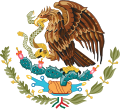
Back بورفيرياتو Arabic پۆرفیریاتۆ CKB Porfiriato Spanish Porfiriat French Porfiriato Italian ポルフィリアート Japanese 포르피리아토 Korean Porfiriaat Dutch Porfiriato Portuguese Порфириат Russian
United Mexican States Estados Unidos Mexicanos | |||||||||
|---|---|---|---|---|---|---|---|---|---|
| 1876–1911 | |||||||||
| Anthem: "Himno Nacional Mexicano" (English: "National Anthem of Mexico") | |||||||||
 | |||||||||
| Government | Federal presidential republic under an authoritarian military dictatorship | ||||||||
| President | |||||||||
• 1876 | Porfirio Díaz | ||||||||
• 1876–1877 | Juan Méndez | ||||||||
• 1877–1880 | Porfirio Díaz | ||||||||
• 1880–1884 | Manuel Flores | ||||||||
• 1884–1911 | Porfirio Díaz | ||||||||
| History | |||||||||
| 10 January 1876 | |||||||||
• Mexican Revolution begins | 20 November 1910 | ||||||||
| 25 May 1911 | |||||||||
| |||||||||
| History of Mexico |
|---|
 |
| Timeline |
|
|

The Porfiriato or Porfirismo (/ˌpɔːrfɪəriˈætoʊ/, Spanish: [poɾfiˈɾjato]), coined by Mexican historian Daniel Cosío Villegas, is a term given to the period when General Porfirio Díaz ruled Mexico under an authoritarian military dictatorship in the late 19th and early 20th centuries.[1][2][3] Seizing power in a coup in 1876, Díaz pursued a policy of "order and progress," inviting foreign investment in Mexico and maintaining social and political order, by force if necessary. There were significant economic, technological, social, and cultural changes during this period.
As Díaz approached his 80th birthday in 1910, having been continuously elected since 1884, he still had not put in place a plan for his succession. The fraudulent 1910 elections are usually seen as the end of the Porfiriato. Violence broke out, Díaz was forced to resign and go into exile, and Mexico experienced a decade of regional civil war, the Mexican Revolution.
- ^ Camp, Roderic Ai, "Porfiriato" in Encyclopedia of Latin American History and Culture, vol. 4, p. 440. New York: Charles Scribner's Sons 1996
- ^ Cosío Villegas, Daniel (1955). Historia Moderna de México. El porfiriato. La vida social [Modern History of Mexico. El Porfiriato, social life] (in Spanish). México: Editorial Hermes.
- ^ Speckman Guerra, Elisa (2011). "El Porfiriato". Nueva historia mínima de México (in Spanish). El Colegio de México. p. 200. ISBN 978-968-12-1139-4.
© MMXXIII Rich X Search. We shall prevail. All rights reserved. Rich X Search

